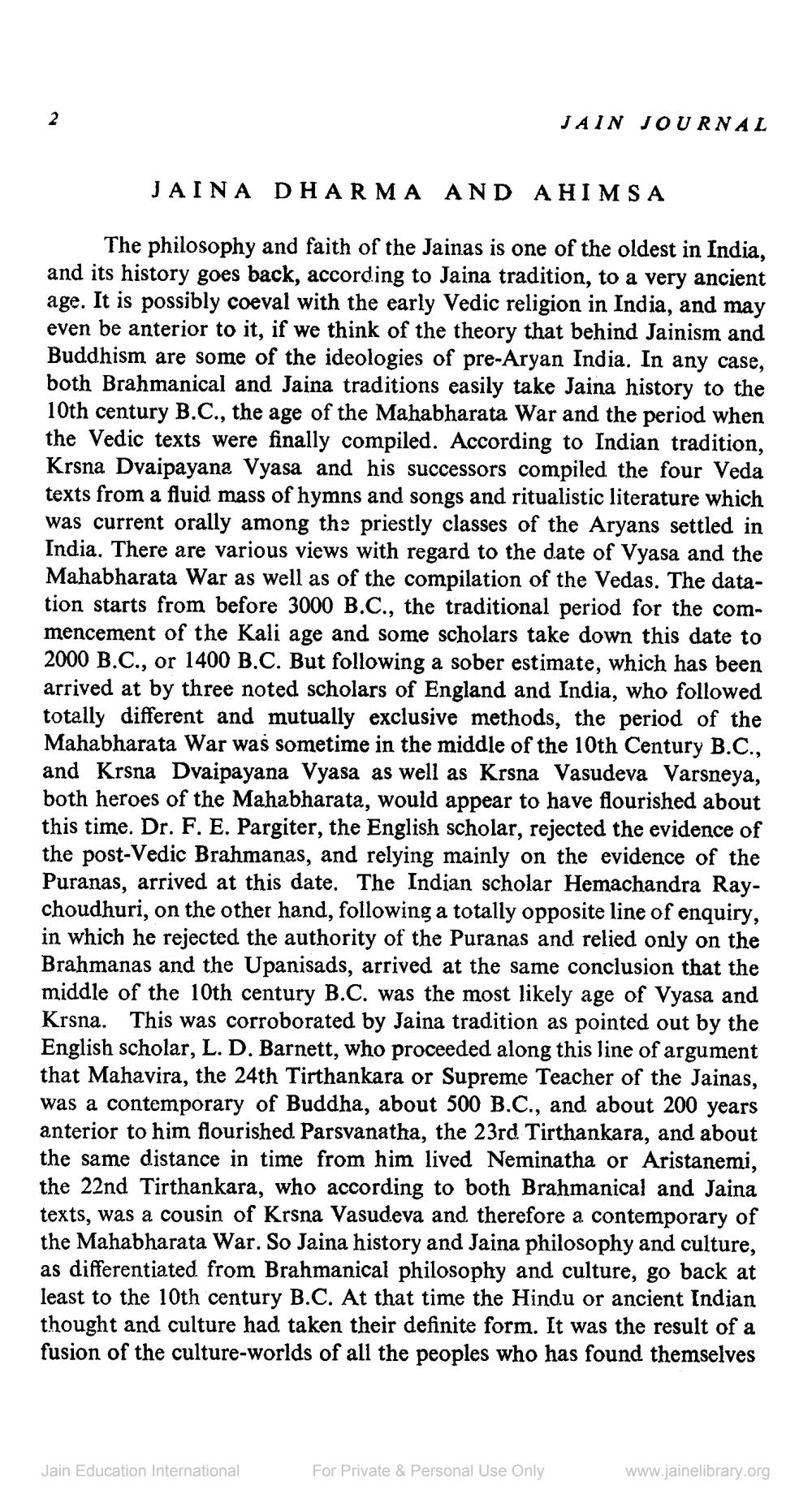Book Title: Jain Journal 1977 07 Author(s): Jain Bhawan Publication Publisher: Jain Bhawan Publication View full book textPage 4
________________ JAIN JOURNAL JAINA DHARMA AND AHIMSA The philosophy and faith of the Jainas is one of the oldest in India, and its history goes back, according to Jaina tradition, to a very ancient age. It is possibly coeval with the early Vedic religion in India, and may even be anterior to it, if we think of the theory that behind Jainism and Buddhism are some of the ideologies of pre-Aryan India. In any case, both Brahmanical and Jaina traditions easily take Jaina history to the 10th century B.C., the age of the Mahabharata War and the period when the Vedic texts were finally compiled. According to Indian tradition, Krsna Dvaipayana Vyasa and his successors compiled the four Veda texts from a fluid mass of hymns and songs and ritualistic literature which was current orally among the priestly classes of the Aryans settled in India. There are various views with regard to the date of Vyasa and the Mahabharata War as well as of the compilation of the Vedas. The datation starts from before 3000 B.C., the traditional period for the commencement of the Kali age and some scholars take down this date to 2000 B.C., or 1400 B.C. But following a sober estimate, which has been arrived at by three noted scholars of England and India, who followed totally different and mutually exclusive methods, the period of the Mahabharata War was sometime in the middle of the 10th Century B.C., and Krsna Dvaipayana Vyasa as well as Krsna Vasudeva Varsneya, both heroes of the Mahabharata, would appear to have flourished about this time. Dr. F. E. Pargiter, the English scholar, rejected the evidence of the post-Vedic Brahmanas, and relying mainly on the evidence of the Puranas, arrived at this date. The Indian scholar Hemachandra Raychoudhuri, on the other hand, following a totally opposite line of enquiry, in which he rejected the authority of the Puranas and relied only on the Brahmanas and the Upanisads, arrived at the same conclusion that the middle of the 10th century B.C. was the most likely age of Vyasa and Krsna. This was corroborated by Jaina tradition as pointed out by the English scholar, L. D. Barnett, who proceeded along this line of argument that Mahavira, the 24th Tirthankara or Supreme Teacher of the Jainas, was a contemporary of Buddha, about 500 B.C., and about 200 years anterior to him flourished Parsvanatha, the 23rd Tirthankara, and about the same distance in time from him lived Neminatha or Aristanemi, the 22nd Tirthankara, who according to both Brahmanical and Jaina texts, was a cousin of Krsna Vasudeva and therefore a contemporary of the Mahabharata War. So Jaina history and Jaina philosophy and culture, as differentiated from Brahmanical philosophy and culture, go back at least to the 10th century B.C. At that time the Hindu or ancient Indian thought and culture had taken their definite form. It was the result of a fusion of the culture-worlds of all the peoples who has found themselves Jain Education International For Private & Personal Use Only www.jainelibrary.orgPage Navigation
1 2 3 4 5 6 7 8 9 10 11 12 13 14 15 16 17 18 19 20 21 22 23 24 25 26 27 28 29 30 31 32 33 34 35 36 37 38 39 40 41 42 ... 52
